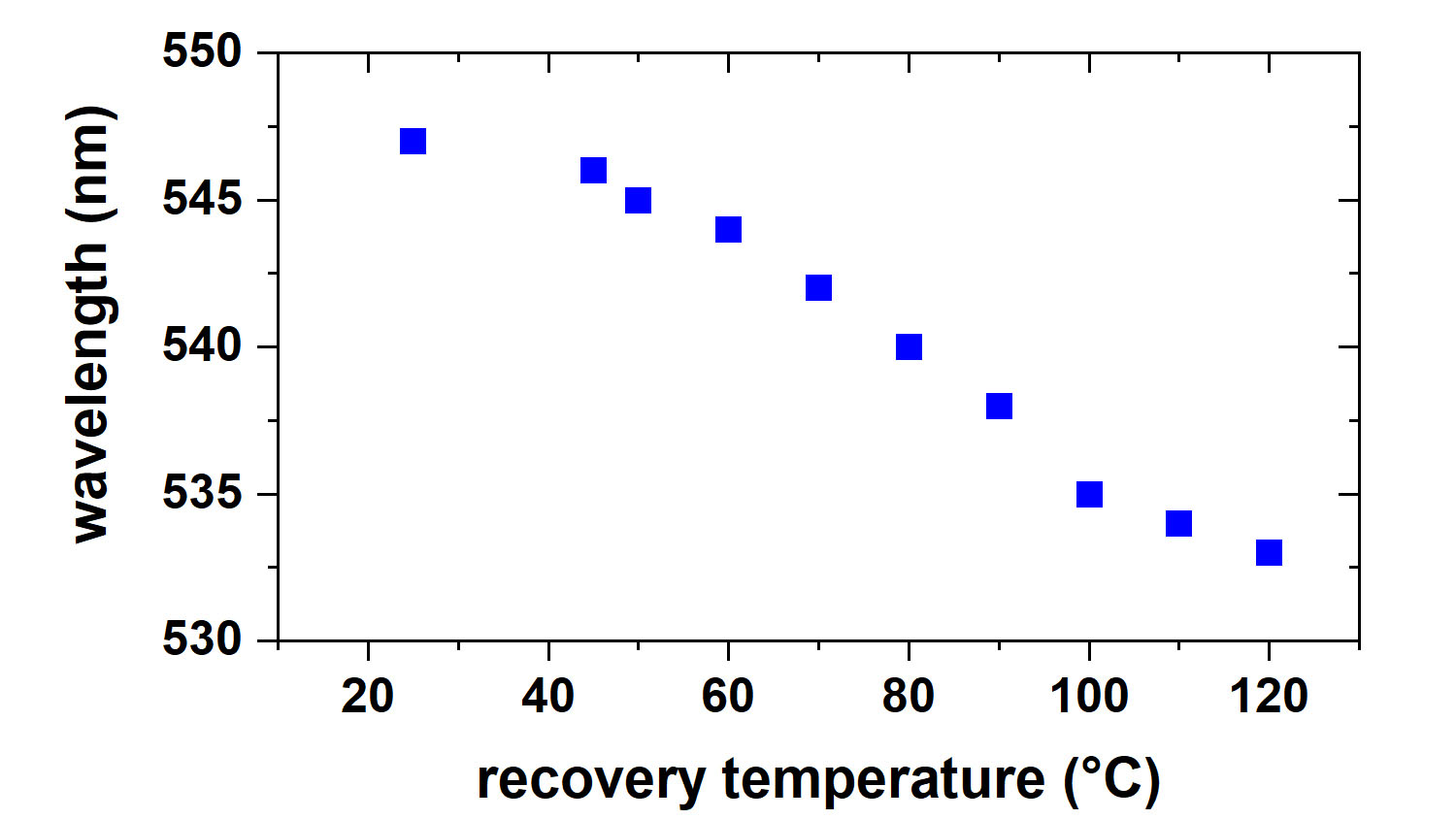Trapped configurations of plasmon-coupled gold nanoparticles useful for thermal history sensing

Researchers have demonstrated that stretching shape-memory polymers embedded with clusters of gold nanoparticles alters their plasmon-coupling, giving rise to desirable optical properties. One potential application for the material is a sensor that relies on optical properties to track an object or environment’s thermal history.
At issue is a stretchable polymer embedded with gold nanospheres. If the material is heated and stretched, followed by cooling to room temperature, the material will hold its stretched shape indefinitely. Once reheated to 120 degrees Celsius, the material returns to its original shape.
But what’s really interesting is that the gold nanospheres are not perfectly dispersed in the polymer. Instead, they form clusters, in which their surface plasmon resonances are coupled. These plasmon-coupled nanoparticles have optical properties that shift depending on how close they are to each other, which changes when stretching alters the shape of the composite.
“When assessing the peak wavelength of light absorbed by the material, there are significant differences depending on whether the light is polarized parallel or perpendicular to the stretching direction,” says Joe Tracy, corresponding author of a paper on the work and a professor of materials science and engineering at NC State. “For light polarized parallel to the direction of stretching, the further you have stretched the material, the further the light absorbed shifts to the red. For light polarized perpendicular to the stretching direction there is a blueshift.”
“We also found that, while the shape-memory polymer holds its shape at room temperature, it recovers its original shape in a predictable way, depending on the temperature it is exposed to,” says Tobias Kraus, co-author of the paper, a group leader at the Leibniz Institute for New Materials and a professor at Saarland University.
Specifically, once stretched 140% past its original length, you can determine the highest temperature to which the polymer is then exposed, up to 120 degrees Celsius, by measuring how much it has shrunk back toward its original size. What’s more, because of the plasmon-coupled nanoparticles, this change can be measured indirectly, through measurements of the material’s optical properties.
“From a practical perspective, this allows you to create an optical thermal-history sensor,” Joe Tracy says. “You can use light to see how hot the material got. An important application of thermal-history sensors is assuring the quality or safety of shipping or storing materials that are sensitive to significant changes in heat. We have demonstrated an approach based on plasmon coupling of gold nanoparticles.”
The sensor concept was developed empirically, but the researchers also used computational modeling to better understand the structure of the clusters of gold nanospheres and how the clusters changed during stretching. The strength of plasmon coupling is related to the spacings between nanospheres, which is known as a “plasmon ruler.”
“Based on our simulations, we can estimate the distance between plasmon-coupled nanoparticles from their optical properties,” says Amy Oldenburg, co-author of the paper and a professor of physics at the University of North Carolina at Chapel Hill. “This comparison is informative for designing future polymer nanocomposites based on plasmon-coupled nanoparticles.”
The paper, “Plasmon-Coupled Gold Nanoparticles in Stretched Shape-Memory Polymers for Mechanical/Thermal Sensing,” appears in the journal ACS Applied Nano Materials. First author of the paper is Prachi Yadav, a former graduate student at NC State. The paper was co-authored by Mehedi Rizvi, Sumeet Mishra, Brian Chapman and Brian Lynch of NC State; and Björn Kuttich of the Leibniz Institute for New Materials.
The work was done with support from the National Science Foundation, under grants 1663416, 1803830 and 1803785; the National Institutes of Health, under grant R21 HL 130901; and the Alexander von Humboldt Foundation.
-shipman-
Note to Editors: The study abstract follows.
“Plasmon-Coupled Gold Nanoparticles in Stretched Shape-Memory Polymers for Mechanical/Thermal Sensing”
Authors: Prachi R. Yadav, Mehedi H. Rizvi, Sumeet R. Mishra, Brian S. Chapman, Brian B. Lynch and Joseph B. Tracy, North Carolina State University; Björn Kuttich, Leibniz Institute for New Materials; Tobias Kraus, Leibniz Institute for New Materials and Saarland University; and Amy L. Oldenburg, University of North Carolina at Chapel Hill
Published: March 25, ACS Applied Nano Materials
DOI: 10.1021/acsanm.1c00309
Abstract: The organization of plasmonic nanoparticles (NPs) determines the strength and polarization dependence of coupling of their surface plasmons. In this study, plasmon coupling of spherical Au NPs with an average diameter of 15 nm was investigated in shape-memory polymer films before and after mechanical stretching and then after thermally driving shape recovery. Clusters of Au NPs form when preparing the films that exhibit strong plasmon coupling. During stretching, a significant polarization-dependent response develops, where the optical extinction maximum corresponding to the surface plasmon resonance is redshifted by 19 nm and blueshifted by 7 nm for polarization parallel and perpendicular to the stretching direction, respectively. This result can be explained by non-uniform stretching on the nanoscale, where plasmon coupling increases parallel to the shear direction as Au NPs are pulled into each other during stretching. The polarization dependence vanishes after shape recovery, and structural characterization confirms the return of isotropy consistent with complete nanoscale recovery of the initial arrangement of Au NPs. Simulations of the polarized optical responses of Au NP dimers at different interparticle spacings establish a plasmon ruler for estimating the average interparticle spacings within the experimental samples. An investigation of the temperature-dependent recovery behavior demonstrates an application of these materials as optical thermal history sensors.
This post was originally published in NC State News.
- Categories:


